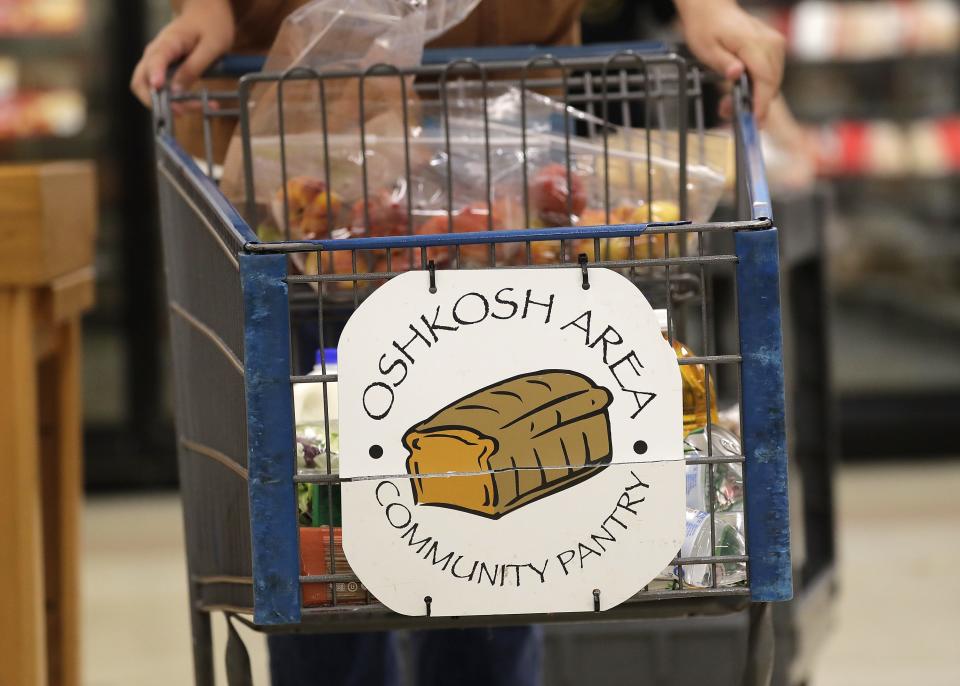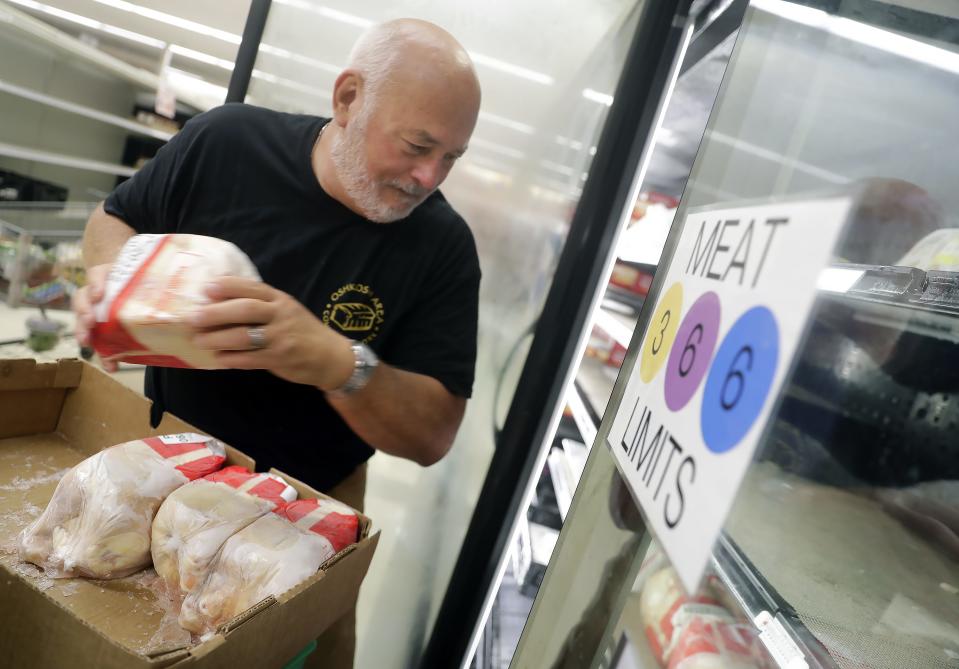As grocery prices remain high in Wisconsin, here's what local food pantries can offer
The cost of groceries has been a major topic over the last few years as, during the pandemic, shoppers began to notice they were spending more money and buying fewer items.
Last July, The Post-Crescent explored the cost of inflation in Wisconsin grocery stores, trying to determine just how much prices had increased.
Using a grocery list made up of every day necessities, we visited a series of stores and compared the overall cost of the store brand groceries to name brand groceries.
Our full grocery list includes: half a gallon of almond milk, a loaf of whole wheat bread, one pound of bacon, one pound of bananas, one pound of 80/20 ground beef, a four-pack of butter, standard box of Cheerios, standard box of Cheez-Its, a dozen eggs, a five pound bag of flour, canned green beans, 18 ounces of strawberry jam, 18 ounces of peanut butter, a head of iceberg lettuce, a gallon of milk, individual naval oranges, a two-pack of paper towels, a six-pack of toilet paper and a standard box of Triscuits.
More: Store brands from Wisconsin grocers can cut your food bill. How much? We went shopping to find out.
At the time of the article, we found some of the highest priced items included eggs, butter and ground beef.
Over a year later, we're exploring whether grocery store prices have changed and how that relates to food relief programs, as part of coverage related to our annual Stock the Shelves fundraising campaign.
The campaign, which runs during October, is a partnership between USA TODAY NETWORK-Wisconsin and Feeding America Eastern Wisconsin. It aims to raise enough funds from readers and the community to support 750,000 meals for those in need. For more information on how to donate, there are details at the end of this article.
Have grocery prices increased since last year?
In September 2022, prices for food at home in the Midwest rose 14.4% since the previous year, according to the Bureau of Labor Statistics. The bureau describes "food at home" as shorthand for the total expenditures for food at grocery stores or other food stores, and food prepared by the consumer while on trips.
Last year, we visited Walmart and found that the total cost of our list, using name brand items, came to $69.67. The highest priced item at the time was $7.98 for a one pound package of Oscar Mayer bacon.
More: Which Wisconsin grocery stores offer the best savings during inflation?
We returned to Walmart this fall with the same list, and using name brand items only, found the total to be $68.94, with Oscar Mayer bacon still the highest priced item at $8.48. Other items came down significantly, however. At the start of the year, a dozen Great Value eggs from Walmart cost $2.87, and now the same pack of eggs costs $1.23.
Although our total dropped by $0.73, overall food prices in the Midwest rose 3.9% over the last year, according to the bureau. Prices for food at home rose 2.8%
"Within the food at home category, prices paid for other food at home, increased by 4.8%, and cereals and bakery products, increased by 5.7%, contributed the most to the rise," the bureau's website stated.
While the food prices are expect to increase more slowly this year than in 2022, they are still above the average historical rates and are expected to continue to grow into next year, according to the US Department of Agriculture.
The bureau concurs, saying that in 2024, all food prices are predicted to increase by 2.8%.
With groceries reaching record high prices, the urge to turn to food aid programs or discount food stores is on the rise, but are food pantries receiving enough?
The demand at food pantries is higher than the supply
In 2023, food pantries across Wisconsin reported they were seeing lower-stocked shelves, with grocery inflation playing a major roll in the shortages.
Monica Clare, executive director of St. Joseph's Food Program in Menasha, last year told USA TODAY NETWORK-Wisconsin that the program's warehouse shelves were at 10% capacity, when normally they would be at 85%.
This year, pantries are still seeing lower stock, and Elizabeth Ahnert, program manager for the Oshkosh Area Community Pantry (OACP) can attest.
"With the demand being higher than ever before, we continue to bring in as much as we can, but when you're serving 2,473 guests per month, that becomes challenging," Ahnert said.
We asked some food pantries what items from our grocery list were often in stock at their facility and what items they could use more of.
For OACP, Ahnert said they carry most of the items on our list, but they tend to run out quickly. The only items on our list which remain consistently available on their shelves are milk, bread and peanut butter.

"It's not that we're not bringing those (other) items in anymore, they are just moving a lot quicker," Ahnert said.
Heather Clohessy, program manager from St. Vincent de Paul in Neenah said the pantry almost always has butter, cereal, eggs, canned green beans, milk and peanut butter. Items that they rarely have in stock include toilet paper and paper towels.
Other items such as almond milk, wheat bread, fruit, and snacks are rarely available, unless donated from Feeding America or other sources.
Ahnert said donations for OACP have been low this year, similar to what food pantries experienced in 2022.

"We continue to leverage our partnerships with Feeding America Eastern Wisconsin and the emergency food assistance program, but for the most part, the deficit has gone up more rapidly," Ahnert said.
At the same time, pantries are seeing an increase in visitors.
The demand is so high for St. Vincent de Paul in Neenah that the pantry is expanding with a whole new building next to the original pantry, set to open at the end of October, Clohessy said.
At the end of February, more than 700,000 people in Wisconsin were impacted by the ending of additional FoodShare benefits provided during the pandemic.
Ahnert said this and the cost of groceries are two major factors in the increase in visitors pantries are seeing.
"Because the pandemic (was) declared (over), FoodShare returned to pre-pandemic levels. Meanwhile, food prices did not return to pre-pandemic levels," Ahnert said.
The Wisconsin Department of Health Services (DHS) reported that the state provided an average of over $931 million in benefits for more than 705,000 recipients in 2023 so far. In July, more than 13,000 people in Outagamie County received benefits. Brown County helped over 27,000 families and Milwaukee County saw over 236,000 participants.
Families with a gross income level at or below 200% of the Federal Poverty Level, which varies by family size, are eligible for FoodShare benefits. Effective Oct. 1, through September 2024, a single person household size with an eligible income will receive a maximum of $291 in benefits. A family of four will receive a maximum of $973.
The DHS website provides a chart and guideline for those wondering if they qualify and how much they might receive.
Ahnert urges the community to donate to their local food pantries, especially items you wouldn't typically think to donate.
"I always tell people, 'When you go to the grocery store, if you're picking up soup that week, pick up an extra can of soup for a family at OACP," Ahnert said. "But then there's those other items that maybe you really like, like Hot Cheetos. Somebody else might really find joy in those during a time when they're facing food insecurity."
How to donate to Stock the Shelves
During October, USA TODAY NETWORK-Wisconsin newspapers and Feeding America Eastern Wisconsin are working together to raise enough money from readers and donors to provide 750,000 meals to Wisconsin families through the annual Stock the Shelves campaign. Each dollar donated equals about four meals, or $10 in food.
The campaign will support communities served by the following newspapers: Milwaukee Journal Sentinel, Green Bay Press-Gazette, Appleton Post Crescent, Manitowoc Herald Times Reporter, Oshkosh Northwestern, Fond du Lac Reporter, Sheboygan Press, Wausau Daily Herald, Wisconsin Rapids Daily Tribune, Marshfield News-Herald, Stevens Point Journal, Door County Advocate and Oconto County Reporter.
Donations will help support people in the same community where the donor lives.
To donate online, visit feedingamericawi.org/stocktheshelvesdonate.
To donate by mail, checks made payable to Feeding American Eastern Wisconsin, ATTN: Stock the Shelves, should be sent to 2911 W. Evergreen Drive, Appleton WI 54913.
Enclose with your contribution the donor’s address with city, state and ZIP code for internal processing, a notation of whether the donation should remain anonymous, whether the donation is in the memory of someone special. Also list the donor’s name as it should appear in a thank-you advertisement to be published in the Thanksgiving editions of USA TODAY NETWORK-Wisconsin’s daily newspapers.
For a list of pantries supported by Feeding America Eastern Wisconsin, visit feedingamericawi.org/find-help.
Reach Jelissa Burns at 920-453-5107 or jburns1@gannett.com. Follow her on Twitter at @burns_jelissa or on Instagram at burns_jelissa.
This article originally appeared on Appleton Post-Crescent: Stock the Shelves: Grocery inflation in Wisconsin continues to pinch public

